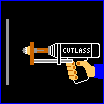Technical Data - CD Stud Welding
| CD and SC Studs |
| CD Stud Weldability Guide |
| CD Reverse-Side Marking Limitations |
| CD Fixturing |
| CD Stud Torque Strength |
Mild steel CD studs are normally manufactured from low carbon mild steels in the C1006 - C1010 range. Mild steel material is typically 55,000 psi minimum ultimate and 35,000 psi minimum yield. Stainless steel CD studs are normally manufactured from 18/8 stainless steels (302HQ, 304, 305). Stainless steel material is typically 75,000 psi minimum ultimate and 30,000 psi minimum yield. Aluminum CD studs are normally manufactured from 5000 series aluminum alloy (5356, 5154), with material properties of 40,000 psi minimum ultimate and 29,000 psi minimum yield. Click here for CD stud torque strength and load strength data.
Stainless steel studs materials most commonly used are types 304 or 302HQ. Other 300 series grades (except 303) are also available when required.
Threads are manufactured to UNC-2A or UNF-2A class of fit (prior to plating) for inch sizes and 6g class of fit for metric sizes.
There is no appreciable change in length of CD studs... studs 1.0" length before weld will be 1.0" long after weld.
CD STUD/BASE METAL COMBINATION WELDING CAPABILITIES
BASE MATERIAL |
STUD MATERIAL |
|||
MILD STEEL |
STAINLESS |
ALUMINUM |
BRASS |
|
MILD STEEL |
Excellent | Excellent | ------------- | Excellent |
MEDIUM CARBON STEEL |
Good* | Good* | ------------- | Good* |
GALVANIZED DUCT |
Excellent | Excellent | ------------- | Excellent |
STRUCTURAL STEEL |
Excellent | Excellent | ------------- | Excellent |
STAINLESS STEEL |
Excellent | Excellent | ------------- | Excellent |
LEAD FREE BRASS, |
Excellent | Excellent | ------------- | Excellent |
MOST ALUMINUM ALLOYS OF THE |
------------- | ------------- | Excellent | ------------- |
DIE-CAST ZINC ALLOYS |
Good* | Good* | Excellent | Good* |
| * Generally full strength results, depending upon the combination of stud size and base metal. | ||||
CD Reverse Side Marking Limitations
HOW TO FIND THE OPTIMUM COMBINATION OF STUD SIZE AND BASE METAL THICKNESS IN ORDER TO PREVENT REVERSE-SIDE MARKING.
EXCELLENT................ no marking, excellent weld.
ACCEPTABLE.............visible markings, excellent weld.
UNACCEPTABLE........unacceptable marking, base metal failure.
It should be noted that these charts are based on optimum laboratory conditions. Even under optimum conditions, it is difficult to determine the precise point at which reverse-side marking will appear. Therefore, these charts should be used as a guide only. Test welding in production conditions is recommended prior to final design and specification.
BASE METAL THICKNESS

MILD STEEL - base metal mild steel, stud flanged or mini-flanged.

STAINLESS STEEL - base metal stainless steel, stud flanged or mini-flanged.

ALUMINUM ALLOY - base metal aluminum alloy, stud flanged or mini-flanged.
NOTE: Stud tip size can have a significant effect on the amount of reverse side marking.

- Spacers are required to allow weld gases to escape.
- Footpiece (part no. 023-252) supplied with CD system.
- Jig Locating Bush (part no. 650-691) supplied with system.
- Adjustable Leg (part no. 000-355) supplied with system.
- Template to be made as required by Customer.
Consult with the factory for other options.

Return to Top

